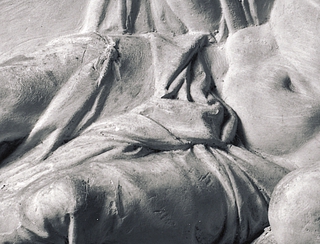Shifting of Attributes - a Fundamental Feature in Thorvaldsen
- Ernst Jonas Bencard, arkivet.thorvaldsensmuseum.dk, 2009
- Translation by David Possen
Thorvaldsen’s play with allegorical attributes is a hitherto unnoticed but nonetheless characteristic feature of his art. This feature is here analyzed in light of a debate in aesthetic theory at the turn of the nineteenth century, during which allegorical portraiture came under harsh critique. It is proposed that Thorvaldsen’s critical approach to allegory be taken as the germ of a new interpretation of his art.
A new discovery
One of the most important distinguishing marks of Thorvaldsen’s works—if not the single most important such mark—consists in his figures’ discreet rebellion against the allegorical attributes with which they are furnished. This pattern lies in plain view, at least to those who have ever taken notice of it; but it has been overlooked until now, and seems as a consequence to have gone wholly unremarked in the literature on Thorvaldsen. Nevertheless, an understanding of this fundamental feature can offer the key to a rereading of Thorvaldsen’s art. The purpose of the present article is to publicize this observation—and to sketch briefly the prospects that it offers.
Hercules and Omphale
Rebellion against preexisting attributes appears for the first time, and most prominently, in Hercules and Omphale, an early (1792) relief dating to Thorvaldsen’s years at the Royal Academy of Fine Arts in Copenhagen.
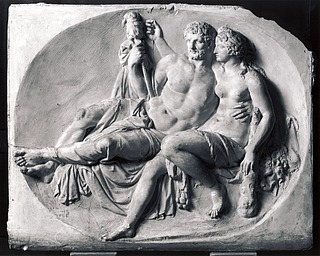
Hercules and Omphale
Original plaster, Museum of Modern Art, Aalborg, AX296
This relief depicts a little-known story about Hercules, champion of classical antiquity, who was sold as a slave to Omphale, queen of Lydia in Asia Minor, as punishment for murder. Although Hercules’ sentence consisted mainly in serving as Omphale’s love-slave, he was also subjected to the indignity of an ancient “gender crossing.” Namely: in typical presentations of the story, Hercules wears a dress and is forced to spin wool, while Omphale arms herself with his attributes of potency: his club and lion skin. At first glance, Thorvaldsen can be thought to have followed this same fixed scheme for representing the pair, inasmuch as all of these ingredients are indeed present in the relief.
In both mythology and sculpture, the affair of Hercules and Omphale seems to have functioned as a moral allegory for a hero’s transformation into a humbled, demasculinized antihero; or as one of the cheerful comedies of errors of Thorvaldsen’s day, i.e., an allegorical reversal of gender relations. Irrespective of the context in which one chooses to inscribe this myth, however, its interpretation rests on the story’s fundamental characteristic: namely, that its actors switch attributes.
As is well known, the attributes of figures are essential to allegorical imagery. For example, in order to understand a female figure as an allegory for justice, one must be able to identify her sword, scale, and blindfold as the accoutrements of Justitia (Justice). The allegory depends on recognition of such conventional signs. By choosing a motif in which the figures’ attributes have been switched and altered, Thorvaldsen situated his work in the midst of a central debate in aesthetic theory at around the year 1800, when allegory was subjected to fierce critique.
Allegory under attack, ca. 1800
Allegorical portraiture is generally regarded as having been widespread in Western art from its very beginnings, first and foremost in the form of history painting (here including “history sculpture”). However, it is commonly thought to have suffered a reversal of fortunes in early modernity, particularly in the wake of Romanticism. J. W. Goethe is reputed to be the theoretician who, during the 1790s, lauded the symbol as the new, modern representational form, as opposed to obsolete allegory.
The distinction between allegory and symbol, meanwhile, is drawn in approximately the same way as is the difference between conventional and natural signs. The meaning of an allegory is fixed in advance, in a machinelike or schematic way; one can look it up in such standard works as Cesare Ripa’s Iconologia. A symbol, on the other hand, can be applied more freely; it has no reading fixed in advance. Its meaning is less clear. An allegory is a kind of “outer” appropriation, while a symbol is an “inner” original creation, etc. As is well-known, this value-laden opposition acquired decisive significance for modernist aesthetics, and left deep tracks in the world of art until well into the twentieth century, when allegory once again came to be ascribed honor and dignity.
When one examines the relevant definitions closely, however, this sharp opposition between allegory and symbol must be relaxed somewhat—as is so often the case with oppositional structures as evolutionary mechanisms in the history of art. The present essay, however, cannot do justice to this matter; it will suffice to point out that the critique of allegory at the start of the nineteenth century marked a turning-point in aesthetic theory, not only for Goethe, but also, for example, for his friend Karl Philipp Moritz, professor of the theory of fine arts (Theorie der schönen Künste) at the academy of arts in Berlin. As early as in 1789, in his article “On Allegory” (Über die Allegorie), Moritz declared programmatically that “where allegory is found, it must always be subordinate, never the main subject—it is only an ornament—and in fact, purely allegorical artworks should not appear at all.”
Alongside this rejection, Moritz offered a positive counterpole to it (which he did not, however, designate as the symbol): “The truly beautiful consists in the fact that a matter has only its own meaning, that it designates itself alone, encompasses itself alone, and is only a complete whole in itself alone.” Here the counterpoles in the debate are articulated more or less clearly: true art (i.e., what was later called the “symbol”) gushes forth from its own independent interior; it is itself, i.e., it is subordinated neither to the compulsion of allegory nor to the conventions of history painting. It is evident how modernism’s cultivation of artistic autonomy and freedom is already emergent here.
It is not unlikely that Thorvaldsen was familiar with this text. We know with certainty that he made use of Moritz’s writings; and it may also be assumed that those at the Academy of Fine Arts in Copenhagen stayed abreast of the monthly journal of their Berlin counterparts, in which Über die Allegorie was published. Whether or not Thorvaldsen actually read Moritz, there is a striking parallel between the writer’s words and the sculptor’s specific design of the Hercules and Omphale motif: in important respects, Thorvaldsen’s reproduction of the scene deviates from the norm. For example, he does not put Omphale’s power over the hero on obvious display. While it is clear that she has taken possession of Hercules’ attributes, this is portrayed discreetly. Omphale’s left arm and hand rest casually on the hero’s club, which otherwise sits inactive on the ground at the corner of the relief; while inconspicuously, in that same corner, Hercules’ lion skin is wrapped around Omphale’s lap.
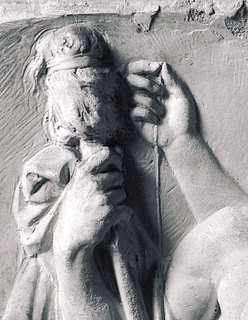 |
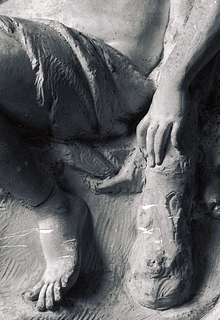 |
Hercules and Omphale, details
Hercules’ humbling is similarly deemphasized. To be sure, the drapery covering the hero’s lap must be understood as the dress that the story requires, thanks to the buckle that (rather piquantly) holds two pieces of drapery together over Hercules’ right thigh. Nevertheless, the dress has slipped down, making it seem more a unisex cloak than a demasculinizing attribute.
Nor does Hercules devote himself to traditional “women’s work,” as he does in both the myth and in its traditional artistic representations. It is rather Omphale who, with her right hand, lifts a barely visible thread of yarn into the air, drawing it from the (equally difficult to identify) unspun wool wrapped around the staff emerging from Hercules’ right hand. Meanwhile, the spindle normally found in the story is not reproduced.
Thus it is that the attributes by which this myth is usually identified are eliminated, marginalized, or markedly underplayed. As Moritz might put it, the scene’s allegorical dimension is not its main event, but is merely an ornament to the matter at hand, which here seems to involve depicting a harmonious pair of lovers. Thorvaldsen conveys this impression with what for a figurative sculptor “has only its own meaning,” namely, the figures’ bodies—which for Thorvaldsen, as for Moritz, are without doubt “the truly beautiful.”
If we now ask why Thorvaldsen chose to portray the peripheral motif Hercules and Omphale, we may suggest that he chose it precisely on account of its play with the fixed meanings of allegory, in order to set forth his own standpoint in one of the most important art-theoretical debates of the day—and likely with a basis in Moritz’s critique of allegory.
Hercules and Omphale thereby contains a self-reflexive, meta-artistic element, calling into question the very status of the allegorical system in contemporary art. To be sure, Thorvaldsen merely posed critical questions; he did not abandon the entire apparatus. Yet by tinkering with it, he paved the way for a less rigidly controlled use of motifs.
Amor as destabilizer
As mentioned above, play with attributes is a structure fundamental to Thorvaldsen’s art, and emerges in settings by no means restricted to the discreet effects we find Hercules and Omphale. Rather, the shifting of attributes appears to have developed into a frame that Thorvaldsen could easily also use to articulate additional themes beyond his critique of allegory per se. In Mars and Amor, for instance, we find a clearer and more extended version of his play with attributes:
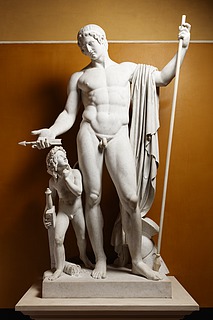
Mars and Amor, A6
Here, once again, the central personages have switched their attributes or distinguishing marks. Mars ponderously contemplates Amor’s arrow, which he holds in his hand, while the god of love shrinks away with the god of war’s sword. Furthermore, the two gods have discarded their remaining attributes. Amor’s quiver lies on the ground, while Mars’ helm rests at his feet; Mars’ hand holds only his spear, but even this is, characteristically, turned upside down, with the point toward the earth. As an attribute, it is inactive, defunctionalized, and removed from its proper context, just as Hercules’ club and other identifying marks are in Hercules and Omphale. The shifting of attributes thus destabilizes the figures’ identity. And this evidently explains Mars’s ponderous ruminations: What is a god of war to do without his weapons? Without my attributes, who am I?
Mars and Amor is in fact a variation on the classical motif Omnia vincit Amor: love conquers all. When the shifting of attributes appears in Thorvaldsen’s works, it is most frequently linked to the disorder that love can bring. For Thorvaldsen, love triumphs over the compulsion of allegory by dissolving the fixed foundation of attributes that underlies it. Amor is the figure depicted most frequently by Thorvaldsen; and this may be explained by the fact that love dissolves or transforms identity in the same way as the removal of attributes. For Thorvaldsen, in other words, these two phenomena go hand in hand.
Shifting of attributes = freedom
The mechanism of Thorvaldsen’s shifting of attributes led not only to shifts in identity. As indicated above, his critique of allegory also set the idea of artistic freedom in motion. Disturbing the fixed foundations of the world of pictorial motifs was no mere artistic affair; it was also a political statement. For as is well-known, allegorical history painting was the favored art form of absolute monarchy. There were thus political undertones to such a critical, investigative, and playful approach to allegory—not least during the revolutionary, anti-royalist 1790s.
Although the political dimension of Thorvaldsen’s art is never articulated directly, the French Revolution’s ideals of freedom nonetheless seem to have left their mark on the sculptor’s works. This is evident, for example, in a pair of pen drawings that simply represent “Freedom”—perhaps an allegory for the short-lived Roman Republic, which existed from 1798 to 1800 as a client state of the newly-established French Republic.
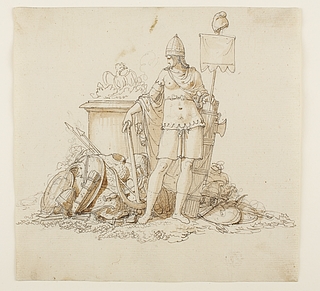
Sketch for a “Freedom” monument, c. 1800, D1590, presumably by Thorvaldsen.
This theme is represented by a female figure traditionally furnished with attributes that identify her as a republican version of “Freedom.” This is especially evident by virtue of the emblem of revolution and freedom par excellence, the Phrygian cap, as well the fasces—a bundle of sticks surrounding an axe, originally an ancient Roman emblem—which was revived by the new French Republic as an image of freedom and justice. While the Phrygian cap and fasces may be regarded as standard attributes for an allegory for Freedom, Thorvaldsen’s two drawings involve them in a shifting of attributes, inasmuch as he equips the goddess of Freedom with other attributes as well. Just as in Hercules and Omphale and in Mars and Amor, Freedom here stands surrounded by ownerless weapons, armor, etc., i.e., a heap of defunctionalized attributes. Both literally and figuratively, freedom rises from the graveyard of attributes. That is, the drawing illustrates pictorially that something new and different is emerging on the basis of a reinterpretation of the old; and this is further emphasized by the altar next to which Freedom stands. Here we see a summarily sketched creature, which must be understood as the bird Phoenix, being consumed by flame—only to return to life in a new form. In other words, the drawing seems to contain a kind of artistic declaration of faith: the first step toward artistic and political freedom is taken by detaching attributes from their usual context. Perestroika for attributes!
If we turn again to Hercules and Omphale, both the drift in identity and the freedom that accompany the shifting of attributes seem to have made marks on the relief: the two actors’ gender identity is “perverted” by the fact that each takes on some of the other’s gender-specific traits. Indeed, they converge: by removing every suggestion of a mistress-slave relationship, Thorvaldsen’s relief displays a hermaphroditic equality of the sexes, giving the impression that the two figures are helping one another in complete harmony. Love has thus “conquered” the myth’s fixed meaning. Here we meet not a ruling absolute hierarchy, but rather the rule of Liberty, Equality, and Fraternity.
Whereas this myth is generally used to portray the woman’s power over the man, Thorvaldsen introduces a displacement into his portrayal, so that the power relation between the genders seems to have vanished. Instead, Hercules and Omphale is marked by a deheroized Biedermeier naturalism that can increasingly be said to emerge in Thorvaldsen’s works. More than a mythological pair, Hercules and Omphale resembles a modern, secularized bourgeois couple—citoyens! A kind of gender utopia can apparently be detected: Hercules and Omphale as the ideal couple of the future. In the wake of the French Revolution’s struggles for liberty, they have received new attributes, new identities, a new relationship, and new freedom.
Broader perspectives
Taking account of the shifting of attributes paves the way for several interesting new modes of perceiving and interpreting Thorvaldsen’s works.
To begin with, Hercules and Omphale highlights its sculptor as a theorizing artist with an interest in his contemporaries’ debates about art—an engagement that is normally not attributed to Thorvaldsen. Yet the question of allegory and symbol clearly played a central role for him; and it is noteworthy that, by shortly after 1800, some of the main participants in the debate had met Thorvaldsen, or knew him rather well, and so certainly could have exchanged viewpoints with him on the status of allegory in contemporary art—such as, for example, the writers A. W. Schlegel and Wilhelm von Humboldt, as well as Thorvaldsen’s fellow Dane Adam Oehlenschläger.
For another, it also emerges that despite his distance from the traditional use of allegory, Thorvaldsen never entirely abandons allegorical imagery or the attributes associated with it. In order to read Thorvaldsen’s works, then, one must first be familiar with the standard mode of presenting a given scene: only then can one discover how the sculptor departs, often discreetly, from the standard system of attributes. Thorvaldsen cultivated nuances, and his works demanded attentive readers—not least because, as is well-known, allegorical imagery was already falling out of fashion during Thorvaldsen’s lifetime. Ever since then, the reading of attributes (and so too sensitivity to the shifting of attributes, as well as to the small changes that this maneuver entails) has been made difficult by the victory of modernism. It is nowadays no longer possible to regard Thorvaldsen’s turn-of-the-century work as cutting-edge contemporary art, for the capacity to take notice of such a critical approach to the mechanisms of allegory has vanished in modernism’s wake. As a result, the reception of Thorvaldsen’s sculpture today is marked not by awareness of his play with attributes, but only by recognition of his cultivation of a formalistic play with harmonies, lines, etc. The allegorical dimension of Thorvaldsen’s art is not taken into account. Rather, his art continues to be regarded as the epitome of dry academic classicism, even though this is in fact what he sought to overturn with the shifting of attributes. The result is that a truly essential side of Thorvaldsen’s work continues to lie fallow.
Finally, a third overarching perspective prompted by this reading of Hercules and Omphale concerns the fact that the shifting of attributes furnishes Thorvaldsen with an enormously flexible body of expressions. Hercules and Omphale contains in germ a variety of themes that would later emerge, in various guises, in other works by Thorvaldsen. These include gender relations, problems of identity, deheroization, freedom of motif, artistic autonomy, the secularization of modernity, the political dimension of art, and more.
With the (re)discovery of Thorvaldsen’s shifting of attributes, it will be possible to attend to these qualities in his works. Indeed: we are now only on the cusp of disclosing what meanings Thorvaldsen’s lively play with attributes will reveal.
References
- Karl Philipp Moritz: ‘Über die Allegorie’, in: Werke in zwei Bänden, Band 1, Berlin & Weimar 1973, (here cited from zeno.org). This article was originally published in Monatsschrift der Akademie der Künste, Berlin 1789.
- L. Müller: Fortegnelse over Malerierne og Tegningerne i Thorvaldsens Museum, Copenhagen 1849.
- Adam Oehlenschläger: ‘Over Allegorien i Almindelighed’, in: F. J. Billeskov Jansen (ed.): Æstetiske Skrifter 1800-1812, Copenhagen 1980, p. 110-117.
- Harald Olsen: “Thorvaldsen og to monumentale Arbejder til De forenede Stater” in Meddelelser fra Thorvaldsens Museum 1947.
- Ovid: “Deianira to Hercules” in Ovid’s Heroides (tr. Harold C. Cannon), London 1972, p. 64-69.
- Craig Owens: “The Allegorical Impulse” in Wallis, Brian (ed.): Art After Modernism: Rethinking Representation, New York 1988.
- Rainer Schoch: “Allegorie auf die römische Republik” in Pülhorn, W. (ed.): Künstlerleben in Rom. Bertel Thorvaldsen (1770-1844). Der dänische Bildhauer und seine deutschen Freunde, Nuremberg 1991.
- Bengt Algot Sörensen (ed.): Allegorie und Symbol. Texte zur Theorie des dichterischen Bildes im 18. und frühen 19. Jahrhundert, Frankfurt a. M. 1972.
- J.M. Thiele: Thorvaldsens Biographi. Efter den afdøde Kunstners Brevvexlinger, egenhændige Optegnelser og andre efterladte Papirer. Thorvaldsen i Rom. 1805-1819 = Thiele II, Copenhagen 1852.
- Tzvetan Todorov: Theories of the Symbol (tr. Catherine Porter), Oxford 1982.
- Carl Frederik Wilckens: Træk af Thorvaldsens Konstner- og Omgangsliv, samlede til Familielæsning, Copenhagen 1874.
Last updated 25.03.2024
